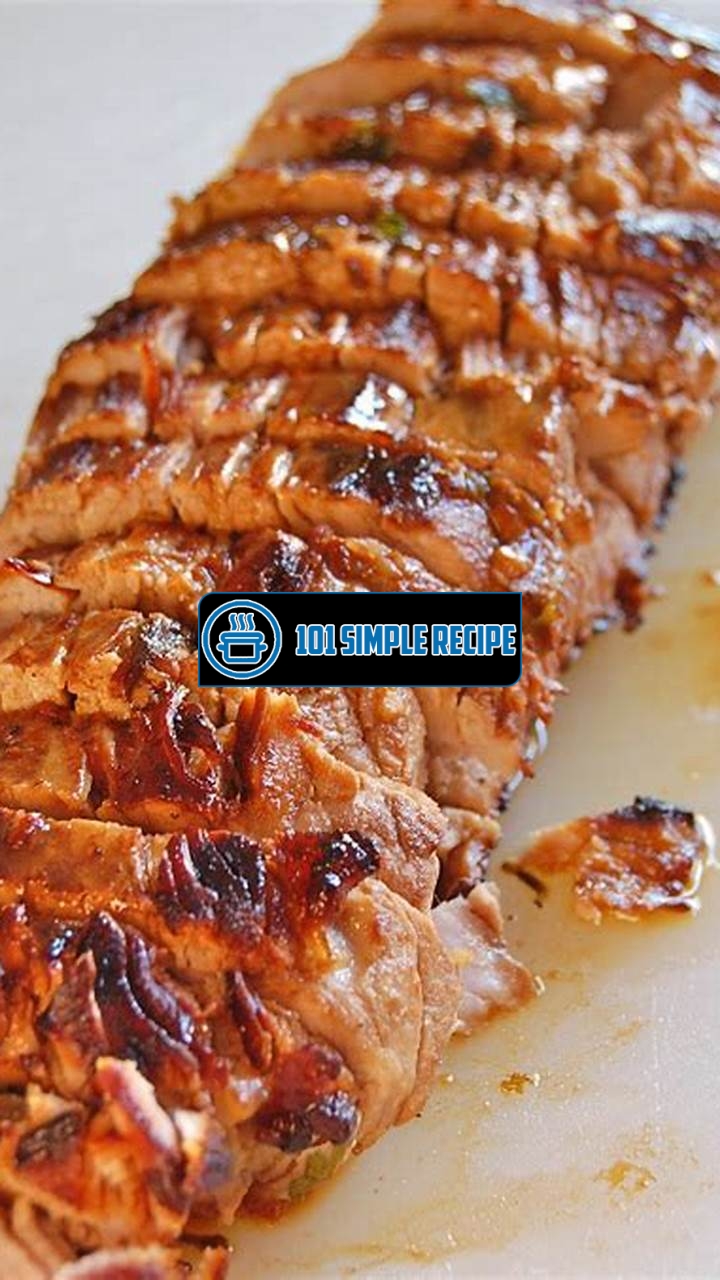Are you searching for a mouthwatering and tender pork loin recipe that will leave your taste buds dancing with joy? Look no further! This delicious pan roasted pork loin recipe is just what you need to impress your family and friends at your next dinner gathering. Bursting with flavor and cooked to perfection, this recipe will turn an ordinary cut of pork into a succulent masterpiece that will have everyone craving for more.

The Versatility of Pan Roasted Pork Loin
Discover the exquisite flavors and techniques associated with pan roasted pork loin, a dish that is sure to impress any crowd.
The Art of Pan Roasting
Pan roasting is a cooking technique that combines the best of both worlds – the tenderness of roasting and the quick cooking time of pan-frying. This method involves searing the pork loin on a hot pan to create a flavorful crust, and then finishing it in the oven to ensure even cooking throughout. The result is a juicy and tender piece of meat with a crispy exterior.
One of the key secrets to successful pan roasting is to use a heavy-bottomed skillet or a roasting pan that can withstand high heat. This will prevent the pork from sticking to the pan and ensure that it cooks evenly.
Before you start pan roasting your pork loin, it’s important to bring it to room temperature. This allows the meat to cook more evenly and ensures that it retains its juiciness. Season the meat with salt and pepper, or any other desired seasonings, to enhance its natural flavors. You can also get creative with the seasonings by adding herbs and spices like rosemary, thyme, garlic powder, or paprika.
When pan roasting, it’s crucial to sear the pork loin properly to develop that desirable golden-brown crust. Heat some oil in the skillet over medium-high heat, and then carefully place the pork loin in the pan. Let it cook undisturbed for a few minutes until a crust forms. Flip the meat and repeat the process on the other side.
Once the pork loin is nicely seared, transfer it to a preheated oven to finish cooking. This method ensures that the interior of the meat reaches the desired temperature without overcooking the exterior. Use a meat thermometer to check the doneness of the pork loin. For a juicy and tender result, the internal temperature should reach 145°F (63°C).
Let the pork loin rest for a few minutes before slicing. This allows the juices to redistribute and ensures that every bite is tender and flavorful. Serve the pan roasted pork loin as a main dish, sliced and accompanied by your favorite side dishes.
The Perfect Cut of Pork Loin
Choosing the right cut of pork loin is essential for the success of your pan roasted dish. The pork loin is a large and lean cut that comes from the back of the pig. It is known for its tenderness and mild flavor, making it a versatile choice for various cooking techniques.
When selecting a pork loin, opt for a boneless cut that is uniform in thickness. This allows for even cooking and ensures that the meat will be tender throughout. Look for a piece of meat that has a minimal amount of fat on the surface, as excessive fat can result in greasy and unevenly cooked pork loin.
If possible, choose a pork loin that has been dry-aged or has undergone a similar process. Dry-aged pork loin tends to have a more concentrated flavor and a tender texture. However, if dry-aged pork loin is not available, a fresh cut will still yield delicious results when properly cooked.
Seasoning and Marinating Techniques for Enhanced Flavor
Seasoning and marinating your pork loin is a crucial step in bringing out its maximum flavor potential. While the natural taste of pork loin is delicious on its own, adding seasonings and marinades can take it to the next level.
A simple yet effective way to enhance the flavor of your pan roasted pork loin is to season it with salt and pepper. These basic seasonings can bring out the natural flavors of the meat and complement its tender texture.
If you want to get creative and experiment with different flavors, consider using a dry rub or a marinade. A dry rub consists of a mixture of herbs, spices, and other seasonings that are rubbed onto the surface of the meat before cooking. This imparts a bold and aromatic flavor to the pork loin.
For a more intense flavor, marinating the pork loin can do wonders. A marinade is a flavorful liquid mixture that the meat is soaked in for a certain period of time. The marinade can include ingredients like soy sauce, Worcestershire sauce, garlic, herbs, and citrus juices. The pork loin absorbs the marinade, resulting in a tender and flavorful meat.
Whether you choose to season with simple salt and pepper or use complex marinades, the key is to let the pork loin marinate for at least a few hours or overnight. This allows the flavors to penetrate the meat and infuse it with deliciousness.
Summing it up, pan roasted pork loin is a versatile and delicious dish that can impress any crowd. The art of pan roasting ensures a juicy and tender result, and the perfect cut of pork loin is essential for success. Experimenting with different seasonings and marinades can enhance the flavor even further. So, grab your skillet, choose a high-quality pork loin, and get ready to savor the mouthwatering flavors of pan roasted pork loin.
Choosing the Right Pan for Pan Roasting
When it comes to achieving the ideal pan roasted pork loin, selecting the right pan is crucial. Different types of pans offer unique qualities that can affect the overall cooking experience and the flavor of the dish. In this section, we will explore three popular options: cast iron pans, stainless steel pans, and carbon steel pans.
Cast Iron Pans: A Classic Choice
Cast iron pans are revered by many chefs for their exceptional heat retention and even cooking abilities. These pans are known for their durability, making them a long-lasting investment for your kitchen. Additionally, cast iron develops a natural non-stick surface over time, which enhances the pan roasting process.
When using a cast iron pan for pan roasting pork loin, start by preheating it over medium-high heat. This ensures that the pan is properly heated throughout, allowing for an even sear on the meat. The high heat of the cast iron helps to create a delicious crust on the exterior while keeping the inside tender and juicy.
Note: Cast iron pans require special care to maintain their seasoning. Avoid using harsh soaps or scouring pads to clean them, as this can strip away the seasoning. Instead, use hot water and a stiff brush to remove any food particles. After washing, thoroughly dry the pan to prevent rusting.
Stainless Steel Pans: Durability and Versatility
Stainless steel pans are a popular choice among home cooks and professional chefs alike due to their durability and versatility. These pans are known for their excellent heat conductivity, allowing for even cooking. They are also resistant to rust and corrosion, making them a reliable option for pan roasting.
When using a stainless steel pan for pan roasting pork loin, it is important to preheat the pan over medium heat. This will prevent sticking and promote a beautiful sear on the meat. Stainless steel pans do not possess the same natural non-stick properties as cast iron, so it is recommended to use a small amount of oil or cooking spray to prevent sticking.
Note: Avoid using metal utensils when cooking with stainless steel pans, as they can cause scratches on the surface. Instead, opt for wooden or silicone utensils to preserve the integrity of the pan.
Carbon Steel Pans: Lightweight and Responsive
Carbon steel pans are loved by professional chefs for their lightweight nature and excellent heat conductivity. These pans heat up quickly and respond rapidly to changes in temperature, giving you precise control over the cooking process. Carbon steel pans are known for their ability to create a beautiful sear on meats, making them an excellent choice for pan roasting pork loin.
When using a carbon steel pan for pan roasting, it is essential to preheat the pan over medium-high heat. This ensures that the surface of the pan is hot enough to sear the meat properly. The even heat distribution of carbon steel results in a consistent and flavorful crust on the pork loin.
Note: Carbon steel pans require proper seasoning and maintenance to prevent rusting. After each use, wash the pan with hot water and a soft sponge. To maintain its seasoning, apply a thin layer of oil to the pan before storing it.
In conclusion, choosing the right pan for pan roasted pork loin can greatly impact the final results. Whether you opt for the classic cast iron, the durable stainless steel, or the lightweight carbon steel, each pan offers unique advantages that enhance the cooking process. Experiment with different pans to find the one that suits your preferences and helps you create a delicious and tender pan roasted pork loin every time.
Mastering the Pan Roasting Process
Mastering the art of pan roasting pork loin can seem intimidating, but with the right techniques, you can achieve a delicious and tender result every time. By following this step-by-step guide, you’ll be able to elevate your cooking skills and impress your family and friends with a perfectly cooked pan roasted pork loin.
Preheating the Pan: Jump-starting Flavor
The first step to achieving a flavorful pan roasted pork loin is preheating the pan. This process helps to jump-start the flavors and create a beautiful caramelization on the outside of the meat.
Note: Preheating the pan ensures that the pork loin cooks evenly and locks in the natural juices for a tender and juicy result.
Start by selecting a heavy-bottomed pan that can retain heat well. Place the pan on the stovetop over medium-high heat and allow it to get hot. This may take a few minutes, so be patient.
Once the pan is hot, add a small amount of oil to the pan. You can choose to use olive oil, vegetable oil, or any other type of oil you prefer. Swirl the oil around the pan to coat the bottom evenly.
Let the oil heat up for a minute or two until it shimmers. This is an indication that the pan is properly preheated.
Searing the Pork Loin: Locking in Juices
The next step in pan roasting the pork loin is searing it to lock in the precious juices. Searing creates a crust on the outside of the meat and enhances the overall flavor and texture.
Note: Searing the pork loin helps to retain the moisture inside, resulting in a juicy and tender final product.
Place the seasoned pork loin carefully into the preheated pan. You should hear a satisfying sizzle as it makes contact with the hot surface.
Allow the pork loin to sear undisturbed for a few minutes. This will help develop a flavorful crust on the outside. Use tongs to flip the loin and sear the other side as well.
Once both sides are seared, you can continue the cooking process according to your recipe. Some recipes may require finishing the pork loin in the oven, while others may call for finishing it on the stovetop.
Finishing in the Oven: Achieving the Perfect Temperature
For the juiciest and most tender pan roasted pork loin, finishing it in the oven is the way to go. This method ensures that the pork loin reaches the perfect internal temperature without overcooking.
Note: Finishing the pork loin in the oven allows for more controlled and even cooking, resulting in a perfectly cooked and juicy piece of meat.
Preheat your oven to the desired temperature indicated in your recipe. Place the seared pork loin onto a baking sheet or roasting pan and transfer it to the oven.
Cook the pork loin in the oven until it reaches the recommended internal temperature. The exact cooking time will depend on the size and thickness of the pork loin, so it’s essential to use a meat thermometer to ensure accurate results.
Once the pork loin reaches the desired temperature, remove it from the oven and let it rest for a few minutes before slicing. This resting time allows the juices to redistribute within the meat, resulting in a moist and flavorful final dish.
By following these steps, you can confidently master the art of pan roasting pork loin. Whether you’re cooking for yourself or hosting a dinner party, your pan roasted pork loin is sure to impress with its tender and juicy perfection.
Accompaniments and Serving Suggestions
When it comes to serving a delicious and tender pan-roasted pork loin, it’s important to choose accompaniments that enhance the flavors and textures of the dish. Whether you’re preparing a special dinner for guests or simply enjoying a meal with family, these side dishes and serving ideas are sure to impress. Here are some mouthwatering options to consider:
Savory Pan Gravy: Elevating the Dish
Nothing pairs better with pan-roasted pork loin than a rich and savory pan gravy. This luscious sauce not only adds moisture to the meat but also elevates the overall flavor profile. To make the perfect pan gravy, start by deglazing the pan with some flavorful stock or broth. Use a wooden spoon to scrape up any browned bits from the bottom of the pan, as these are packed with delicious flavor. Add a touch of flour to create a roux, which will thicken the gravy. Then, slowly whisk in the stock until the mixture reaches the desired consistency. Finish with a sprinkle of fresh herbs, such as thyme or rosemary, for an extra burst of flavor.
- Tip: For a burst of flavor, add a splash of red wine or balsamic vinegar to your pan gravy. This will add depth and complexity to the sauce.
Roasted Vegetables: The Perfect Complement
Roasted vegetables are a classic choice to serve alongside pan-roasted pork loin. The caramelization that occurs during roasting brings out the natural sweetness of the vegetables, adding a delightful contrast to the savory pork. Some excellent options to consider include roasted potatoes, carrots, Brussels sprouts, and butternut squash. Simply toss your chosen vegetables with olive oil, salt, and pepper, and spread them out on a baking sheet. Roast in a hot oven until golden and tender. The result is a colorful and flavorful accompaniment that will have everyone reaching for seconds.
- Pro Tip: To add an extra touch of flavor, sprinkle your roasted vegetables with some grated Parmesan cheese or drizzle them with a balsamic glaze before serving.
Refreshing Salads: Balancing the Meal
To balance out the richness of the pan-roasted pork loin, consider serving a refreshing salad on the side. The crispness and acidity of the salad will help cut through the richness of the meat, creating a well-rounded and satisfying meal. Opt for a mix of vibrant greens, such as arugula or baby spinach, and add toppings such as cherry tomatoes, sliced cucumbers, and tangy feta cheese. Finish with a light dressing, such as a lemon vinaigrette, to tie all the flavors together. Not only will the salad provide a burst of freshness, but it will also add a pop of color to your plate.
Remember, when serving a salad with pan-roasted pork loin, choose flavors and textures that complement the meat rather than overpowering it. Keep it light and refreshing.
In conclusion, when it comes to serving pan-roasted pork loin, the accompaniments and serving suggestions you choose can make all the difference. From a delectable pan gravy that adds richness to roasted vegetables that provide a perfect balance, these side dishes are sure to impress. Add a refreshing salad to the mix, and you’ve got a meal that is packed with flavor and guaranteed to satisfy. So, the next time you prepare pan-roasted pork loin, consider these delicious options and elevate your dining experience.
Variations and Flavor Enhancements
When it comes to pan roasted pork loin, there are countless variations and flavor enhancements that can elevate this classic dish to new heights. By thinking outside the box and incorporating inventive twists, you can create a mouthwatering meal that will impress your friends and family. From herb crusts to fruit glazes, and spice rubs to marinades, there are endless possibilities to explore.
Herb Crust: Infusing Aromatic Flavors
One way to enhance the flavor of your pan roasted pork loin is by creating a delicious herb crust. This not only adds a burst of aromatic flavors, but also creates a beautiful crust that locks in the juiciness of the meat. You can use a variety of herbs such as rosemary, thyme, and sage to create a herb crust that complements the natural flavors of the pork.
To make the herb crust, simply combine the herbs with breadcrumbs, garlic, and olive oil. Spread the mixture evenly over the pork loin before roasting it in the pan. The result is a tender and flavorful pork loin with a crispy and fragrant herb crust.
Fruit Glaze: A Sweet and Tangy Twist
If you’re looking to add a touch of sweetness and tanginess to your pan roasted pork loin, a fruit glaze is the perfect choice. Whether you opt for an apricot glaze, a cranberry glaze, or even a pineapple glaze, the fruity flavors will complement the savory pork and create a delightful combination of tastes.
To make a fruit glaze, simply simmer your chosen fruit along with sugar, vinegar, and spices until it thickens into a glossy glaze. Brush the glaze over the pork loin before roasting it in the pan. The result is a succulent pork loin with a caramelized and flavorful fruit glaze.
Spice Rubs and Marinades: Adding a Kick of Flavor
For those who love a bit of heat and bold flavors, spice rubs and marinades are the way to go. By infusing the pork loin with a blend of spices and allowing it to marinate, you can create a dish that is bursting with flavor from the inside out.
To make a spice rub, combine your favorite spices such as paprika, cumin, chili powder, and garlic powder. Rub the mixture all over the pork loin and let it sit for at least an hour, allowing the flavors to penetrate the meat. Then, simply roast the pork loin in the pan until it’s cooked to perfection.
If you prefer a marinade, combine soy sauce, ginger, garlic, and a touch of sweetness like honey or brown sugar. Let the pork loin marinate in this flavorful mixture for a few hours or overnight. When you’re ready, pan roast the pork loin and enjoy the explosion of flavors in every bite.
In conclusion, the possibilities for variations and flavor enhancements of pan roasted pork loin are truly endless. Whether you choose to infuse aromatic flavors with a herb crust, add a sweet and tangy twist with a fruit glaze, or spice things up with a bold rub or marinade, you can take this classic dish to a whole new level. Get creative in the kitchen and experiment with different flavors to find your own signature pan roasted pork loin recipe. Happy cooking!
Frequently Asked Questions
Thank you for reading our article on pan roasted pork loin! We hope you found it informative and inspiring for your next culinary adventure. If you have any further questions, feel free to take a look at our FAQ section below:
| No. | Questions | Answers |
|---|---|---|
| 1 | What is the best cut of pork for pan roasting? | The best cut of pork for pan roasting is the pork loin. It is tender and juicy when cooked properly, making it a perfect choice for this cooking method. |
| 2 | How do I achieve a crispy crust on the pork loin? | To achieve a crispy crust on the pork loin, make sure to pat the meat dry before seasoning and searing it. This will help remove excess moisture and allow for a beautiful caramelized crust. |
| 3 | What temperature should the pork loin reach for doneness? | The pork loin should reach an internal temperature of 145°F (63°C) for medium-rare doneness. Use a meat thermometer to ensure accurate results. |
| 4 | Can I substitute pork loin with a different cut of meat? | While pork loin is the recommended cut for pan roasting, you can experiment with other cuts such as pork tenderloin or boneless pork chops. Just adjust the cooking time accordingly. |
| 5 | What are some delicious side dishes to serve with pan roasted pork loin? | Some delicious side dishes to serve with pan roasted pork loin include roasted vegetables, mashed potatoes, green beans, or a refreshing salad. |
| 6 | Can I make a pan sauce from the drippings? | Absolutely! You can make a delicious pan sauce by deglazing the pan with some wine or broth, scraping off the browned bits, and then reducing the liquid until it thickens. |
Thank You and Visit Again!
We hope you enjoyed learning about the art of pan roasted pork loin. Whether you’re a seasoned chef or a novice in the kitchen, this versatile dish is sure to impress. Don’t forget to visit our website again for more delicious recipes, cooking tips, and culinary inspiration. Cook with passion and savor the flavors!
Jump to Recipe
Pan Roasted Pork Loin

Learn how to make the perfect pan roasted pork loin with this easy and flavorful recipe. The pork loin is seared to create a crispy crust and then roasted to perfection, resulting in a tender and juicy main dish.
- 1 2-pound pork loin
- 2 tablespoons olive oil
- 1 tablespoon Dijon mustard
- 2 cloves garlic (minced)
- 1 teaspoon dried rosemary
- Salt and pepper (to taste)
- Preheat the oven to 375°F (190°C).
- Heat olive oil in a large oven-safe skillet over medium-high heat. Season the pork loin with salt and pepper, then sear it on all sides until browned.
- In a small bowl, mix together Dijon mustard, minced garlic, and dried rosemary. Spread the mixture evenly over the seared pork loin.
- Transfer the skillet to the preheated oven and roast the pork loin for about 35-40 minutes, or until the internal temperature reaches 145°F (63°C).
- Remove the pork loin from the oven and let it rest for 5 minutes. Slice the pork loin into thick slices and serve.






